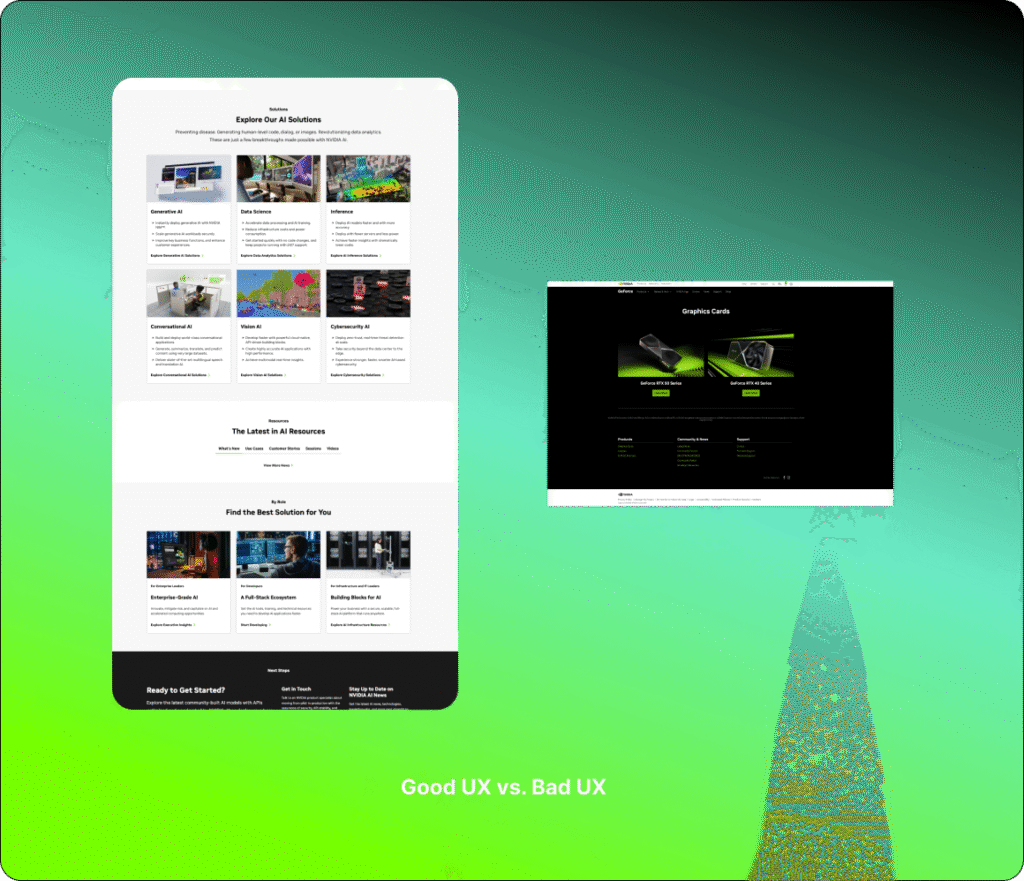
NVIDIA’s September splashdown certainly made waves—but like most tsunamis, the aftermath reveals both exhilarating possibilities and sobering realities. Their ambitious quartet of announcements deserves scrutiny across the digital ecosystem, stripped of both fangirl enthusiasm and cynical dismissal.
The Digital Marketing Perspective: Messaging That Mostly Misses

What’s Actually Working
NVIDIA’s brand storytelling deserves grudging respect. The narrative arc from “AI is transforming biology” to “personal AI supercomputers” to “national AI infrastructure” reads like a coherent corporate thriller. They’ve mastered the art of making hardware feel inevitable rather than merely desirable.
Their multi-channel approach is textbook excellent. The company leverages everything from YouTube cinematics to venture capital relationships. The DGX Spark video, in particular, transforms what could have been a dry product announcement into something approaching techno-poetry.
Looking at the YouTube metrics tells an interesting story: “The U.K.’s Next Industrial Revolution” has garnered 1.1 million views in just six days, whilst “A Personal AI Supercomputer for Accelerated Protein AI” managed 28,000 views in seven days. This suggests their geopolitical narratives resonate more powerfully than technical product launches.
“DGX Spark is more than a workstation. It’s a personal AI supercomputer for digital biology, bringing capabilities once reserved for elite institutions to researchers everywhere.”
That’s messaging that connects to deeper human needs around democratisation and access—precisely the kind of emotional resonance that transforms products into movements.
Where the Wheels Come Off
The pricing communication is absolutely dreadful. At £3,999, DGX Spark sits in an uncomfortable middle ground—too expensive for hobbyists, potentially too limited for serious enterprise use. Yet nowhere in their messaging do they adequately address this positioning challenge.
More damning is the expectation management disaster. NVIDIA’s track record with product availability remains problematic. The company seems constitutionally incapable of learning that overpromising and underdelivering destroys brand equity faster than any competitor could.
Their audience segmentation remains frustratingly broad. The same messaging tries to serve AI researchers, pharmaceutical companies, national governments, and venture capitalists. This inevitably pleases none completely.
The UX Writer’s Perspective: Copy That Confuses

The Genuinely Good Bits
The hierarchical messaging works beautifully in the UK infrastructure announcement. Starting with steam engines and electricity before landing on AI creates genuine narrative momentum. It’s copy that acknowledges cultural context rather than assuming everyone lives in Silicon Valley.
The technical specifications are presented with admirable clarity. Terms like “128GB of coherent memory” and “one petaflop of compute” might be jargon to most, but for the target audience, these details provide essential decision-making information.
Where It Falls Apart Completely
The cognitive load across these announcements is exhausting. Users encounter Nemotron, BioNeMo, DGX Spark, DGX Station, Grace Blackwell, Vera Rubin, and about seventeen other product names without clear differentiation or hierarchy.
Call-to-action ambiguity plagues every announcement. “Sign up for your own today” for DGX Spark—but where? When? What’s the actual process beyond putting down a reservation that might never materialise?
The tone inconsistency between announcements suggests different teams working in isolation. The UK partnership announcement reads like government PR, whilst the protein AI content feels like academic publishing. Clear brand voice consistency across all touchpoints is absolutely essential.
What I’d Do Differently
Create a unified product taxonomy that ordinary humans can navigate. Establish clear content hierarchy: start with the problem, introduce the solution, then layer in technical specifications. Most importantly, test the copy with actual users rather than engineers—much like the approach we’d take in comprehensive UX writing services.
The AI Evangelist’s Take: Vision Meets Vertigo

The Revolutionary Potential
NVIDIA’s ecosystem thinking is genuinely impressive.
The ability to prototype on DGX Spark, scale to DGX Cloud, then deploy on national infrastructure represents the kind of seamless workflow that could genuinely accelerate AI adoption.
The YouTube data reveals something interesting: their Nemotron video has only 7,000 views despite being one day old. This suggests either poor promotion or limited audience interest in open-source AI development tools—both concerning for a cornerstone strategy.
The Nemotron open-source strategy is particularly clever. By democratising AI development tools whilst maintaining hardware lock-in, NVIDIA creates switching costs without appearing predatory. It’s platform strategy executed with considerable sophistication—reminiscent of the strategic thinking we see in successful AI campaign positioning.
The Sobering Realities
Hardware limitations remain brutally constraining. 128GB sounds impressive until you realise that frontier models increasingly require multiple terabytes of memory. DGX Spark might democratise yesterday’s AI capabilities whilst tomorrow’s remain firmly in the cloud.
The energy infrastructure implications are barely acknowledged. National AI strategies requiring tens of thousands of GPUs will strain electrical grids already struggling with renewable transition challenges.
Vendor lock-in concerns are legitimate. NVIDIA’s “open” strategy still channels users toward proprietary software stacks and hardware architectures. The openness feels more like marketing tactic than genuine platform neutrality.
Strategic Pivot Recommendations
Focus on interoperability as a genuine differentiator. Create migration paths that don’t punish users for choosing alternatives.
Build energy efficiency into the core messaging—position NVIDIA as enabling sustainable AI rather than merely faster AI.
This requires the kind of strategic planning approach that considers long-term market dynamics rather than quarterly metrics.
The End User Reality: Promises vs. Practicalities

What Users Actually Need
Reliability over raw performance. The AI community has been burned repeatedly by availability issues, buggy drivers, and overpromised capabilities. Users need hardware they can actually buy and software that works consistently.
Clear upgrade pathways. Most users can’t afford to replace their entire AI infrastructure every generation. They need systems that can grow incrementally rather than requiring wholesale replacement.
Honest performance benchmarks. Marketing videos showing smooth protein folding simulations don’t help users understand real-world performance with their specific datasets and workflows.
Where NVIDIA Actually Delivers
The software ecosystem genuinely provides value. CUDA’s ubiquity means that choosing NVIDIA reduces integration friction across the entire AI development stack.
Community support remains excellent. The combination of official documentation, community forums, and third-party resources makes NVIDIA hardware relatively approachable for newcomers.
The Persistent Pain Points
Pricing accessibility remains the elephant in the room.
At £3,999, DGX Spark costs more than most researchers’ annual hardware budgets. The democratisation narrative rings hollow when the barrier to entry remains so high.
Availability management continues to disappoint. The gap between announcement and actual availability has become a running joke in AI communities.
Performance predictability varies wildly. Users report significant performance degradation when offloading becomes necessary, making capacity planning extremely difficult.
The Synthesis: Strategic Strengths, Tactical Stumbles
NVIDIA’s September announcements reveal a company with extraordinary strategic vision hampered by persistent tactical execution problems. The ecosystem thinking is genuinely impressive—few companies could credibly announce personal computers, national infrastructure, open-source software, and venture capital initiatives as part of a coherent strategy.
However, the messaging fragmentation, pricing opacity, and availability management issues suggest an organisation struggling to scale its marketing and customer experience capabilities as rapidly as its technical achievements.
The Recommendation Matrix
For Digital Marketers: Study NVIDIA’s narrative construction whilst avoiding their pricing communication and expectation management mistakes. The storytelling framework is excellent; the tactical execution needs work. Consider how strategic campaign planning could prevent these fragmented experiences.
For UX Professionals: Observe how technical complexity can be made accessible through careful information hierarchy. But don’t emulate their cognitive load management or call-to-action clarity—these are precisely the areas where thoughtful microcopy makes the difference between confusion and conversion.
For AI Practitioners: Engage with the technology whilst maintaining healthy scepticism about timelines and availability. The capabilities are real; the accessibility claims require verification.
For End Users: Consider NVIDIA products as part of longer-term infrastructure planning rather than immediate solutions. The ecosystem benefits are genuine, but factor in realistic availability and upgrade timelines.
Learning from AI Marketing Excellence
What’s particularly fascinating is how NVIDIA’s approach contrasts with other recent AI marketing efforts. Unlike Google’s Nano Banana campaign, which succeeded through delightful simplicity, or Anthropic’s Claude positioning, which built trust through vulnerability, NVIDIA attempts to inspire through technological grandeur.
The YouTube performance data supports this observation: simple, emotionally resonant content (UK Industrial Revolution) dramatically outperforms technical product announcements (DGX Spark, Nemotron). The lesson here: even sophisticated audiences respond to emotional narrative frameworks.
The results are mixed. NVIDIA’s visionary approach creates genuine excitement amongst technologists but struggles with practical adoption barriers. The lesson: grand vision requires equally sophisticated execution—something that demands comprehensive strategy and planning rather than feature-focused marketing.
The YouTube Reality Check
The performance metrics tell a sobering story:
- UK Industrial Revolution: 1.1M views (emotional storytelling wins)
- DGX Spark: 28K views (technical products struggle)
- Nemotron: 7K views (open-source positioning fails to engage)
- Sofinnova Partnership: 2.3K views (B2B content predictably limited)
This data suggests NVIDIA’s emotional and geopolitical narratives resonate far more powerfully than technical product launches or partnership announcements. The company succeeds when it tells stories about transformation rather than specifications about performance.
For brands seeking similar success, this indicates the importance of storytelling that connects to larger human narratives rather than merely listing features and capabilities.
Final Assessment
The real test isn’t whether NVIDIA’s September announcements represent good technology—they clearly do. The question is whether the company can execute customer experience with the same sophistication as their silicon design. On that front, the jury remains frustratingly, emphatically out.
For brands looking to learn from both NVIDIA’s successes and stumbles, the key insight is clear: technological capability without thoughtful communication strategy creates more confusion than conversion. The most sophisticated AI in the world still needs human-centred messaging to reach its potential.
NVIDIA’s September showcase ultimately represents a company at an inflection point—capable of extraordinary vision but still learning how to translate that vision into accessible, actionable user experiences. The technology is undoubtedly impressive; the execution remains delightfully, frustratingly human.
Sources:
- NVIDIA YouTube Channel Performance Data, September 2025
- NVIDIA DGX Spark Product Announcement Video (28K views, 7 days)
- NVIDIA UK AI Infrastructure Partnership Video (1.1M views, 6 days)
- Sofinnova Partners NVIDIA Collaboration Video (2.3K views, 2 days)
- Why NVIDIA Built Nemotron Video (7K views, 1 day)
- NVIDIA Marketing Strategy Analysis – Skill Circle
- NVIDIA DGX Spark Technical Specifications
- NVIDIA UK Investment Details
- NVIDIA Developer Forum Customer Feedback
- https://www.youtube.com/@NVIDIA
- https://www.youtube.com/watch?v=_y9SEtn1lU8
- https://www.youtube.com/watch?v=mhIOr_vHl_Y
- https://www.youtube.com/watch?v=7G0YSn2–EM
- https://www.youtube.com/watch?v=3GhckKPLDd4
- https://www.youtube.com/watch?v=Xzg3Ty8vAQ8
- https://www.youtube.com/watch?v=rAsQ9EgsxYE
- https://www.youtube.com/watch?v=meAxdUNgAsA
- https://www.youtube.com/watch?v=Xzg3Ty8vAQ8&pp=0gcJCesJAYcqIYzv
- https://www.youtube.com/watch?v=6p4U1kSiegg
- https://www.youtube.com/watch?v=kZRMshaNrSA
